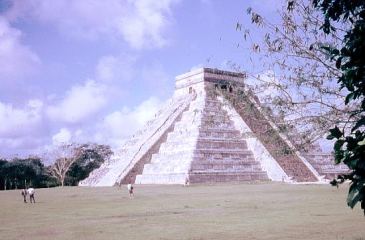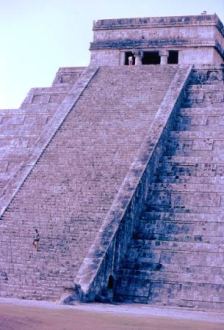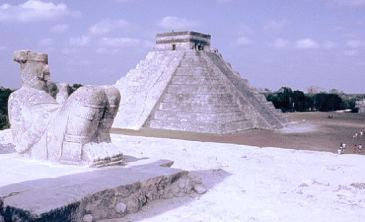Did You Know…?

Modern sound recordings usually involve tiny disks which can hold dozens of tracks, specially designed to be easily portable and convenient. The Maya may have had different priorities. David Lubman has proposed that the earliest sound recording so far discovered on the planet may well be the main pyramid at Chichen Itza in the Yucatan.
We may never know whether it was originally accidental or intentional, but the sound can still be heard today, by standing in front of the pyramid and making a single hand clap. The resulting echo, from the pyramid’s staircase, is unusual, sounding like a downward chirp. Lubman makes a strong case for this chirp to be a deliberate representation of the call of the Respendant Quetzal bird. This bird, described in Peterson and Chalif’s Field Guide to Mexican Birds as “the most spectacular bird in the New World” was formerly common in the rainforest which originally cloaked this entire region. Quetzal birds were sacred to the Maya, and their feathers were highly prized.

Links between the main pyramid at Chichen Itza, known as the Pyramid of Kukulkan, and the quetzal bird are supported by the fact that Kukulkan was a Mayan deity, the feathered serpent (usually known in central Mexico as Quetzalcoatl). Depictions of Kukulkan often show the distinctively long feathers of the quetzal. The pyramid’s construction is so precise that at the equinoxes, the sun striking one side casts an undulating shadow down the stairway looking remarkably like the body of a serpent.
Visitors to the pyramid often remark on the unusually narrow steps and the height of the risers between them. Previous explanations have tended to explain them in terms of aesthetics, rather than function. Lubman, however, believes that they were very carefully and deliberately designed in order to create the chirped echo effect. His measurements and calculations suggest that the length of the staircase results in the complete echo lasting more than 100 milliseconds. The reason it sounds like a downward chirp is because the complete echo is actually made up by a whole series of individual echos, one from each of the 92 steps making up the sloping stairway. Since the steps are progressively further away from the listener as the sound travels up the staircase, the successive echos are also correspondingly delayed fractionally, and arrive with different frequencies. The end result? An echo that sounds remarkably like a quetzal bird.

The effect is best heard from relatively close to the pyramid. From three or four meters in front of the stairway, the chirp is clear. From further back, the difference in frequencies is small and the effect less obvious.
So, next time you’re in Chichen Itza, try and arrive before the crowds, and test the hand clap echo for yourself. When you do so, spare a thought for the ancient Maya people who may have done just the same 1300 years ago. Perhaps they too marvelled at the result!
This article is the basis for Chapter 4 in the author’s Mexican Kaleidoscope: myths, mysteries and mystique (Sombrero Books, 2016).
Sources
- Lubman, David (1998) “Archaeological acoustic study of chirped echo from the Mayan pyramid at Chichen Itza, in the Yucatan Region of Mexico… Is this the world’s oldest known sound recording?”. Paper presented to the 136th Meeting of the Acoustical Society of America, October 1998.
- Lubman, David (2002) “More on the Mayan Pyramid”. Article on the website of the Orange County Regional Chapter of the Acoustical Society of America.

